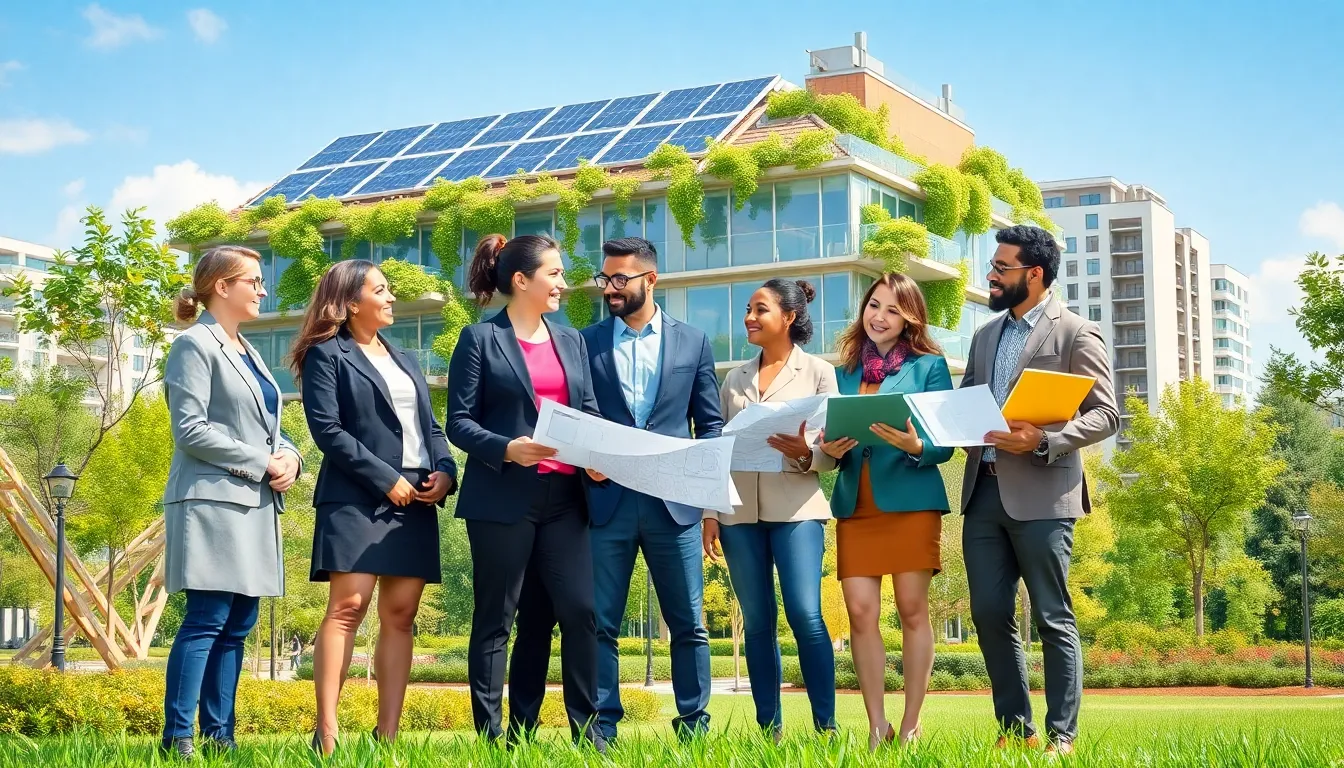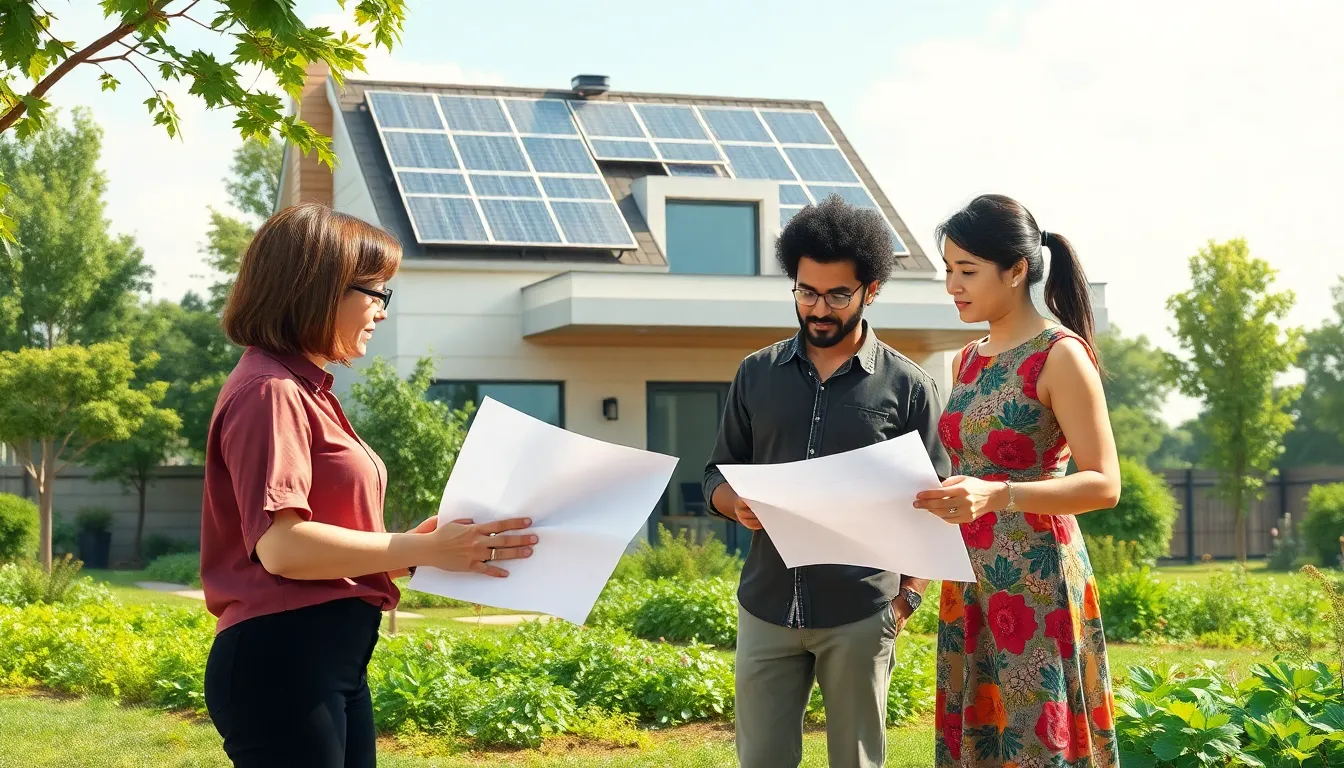In a world where Mother Nature has a knack for throwing tantrums, the real estate industry is stepping up its game. Gone are the days of cookie-cutter homes that suck energy like a vampire at a blood bank. Today’s buyers are on the hunt for sustainable options that not only save the planet but also save their wallets.
With eco-friendly materials and energy-efficient designs taking center stage, real estate sustainability trends are transforming the market. From solar panels that practically pay for themselves to smart homes that make even your coffee maker feel guilty about wasting energy, the future of housing is looking greener than ever. So buckle up as we explore the exciting trends that are reshaping the landscape—because who said saving the planet couldn’t be stylish?
Table of Contents
ToggleOverview of Real Estate Sustainability Trends
Real estate sustainability trends reflect a significant shift toward eco-friendly practices in the housing market. New constructions prioritize energy efficiency, which reduces utility costs and enhances living comfort. Numerous builders now incorporate renewable energy sources, like solar panels, into their designs. Smart home technology features, such as advanced thermostats and energy monitoring systems, contribute to lower energy consumption.
Materials used in construction increasingly favor eco-friendly options. Sustainability leaders promote materials that minimize environmental impact, including reclaimed wood and recycled metal. These strategic choices resonate with buyers seeking homes that align with environmental values while remaining stylish.
Community planning plays a crucial role in developing sustainable real estate. Walkable neighborhoods featuring access to public transportation reduce reliance on personal vehicles. Integration of green spaces and parks enhances residents’ quality of life. Innovative developments emphasize urban farming and community gardens, supporting local ecosystems and food sources.
Water conservation techniques significantly shape modern real estate trends. Advanced irrigation systems efficiently use water for landscaping. Rainwater harvesting systems provide sustainable solutions for irrigation needs.
Building certifications, such as LEED and Energy Star, influence buyer decisions. Properties receiving these certifications demonstrate a commitment to environmental stewardship. Prospective buyers increasingly seek out these credentials, indicating heightened awareness and demand for sustainable housing options. This focus on sustainability propels ongoing evolution within the real estate market.
Importance of Sustainability in Real Estate

Sustainability plays a crucial role in the modern real estate landscape, addressing both environmental concerns and market demands. Emphasizing eco-friendly practices fosters a healthier planet and contributes to economic stability.
Environmental Impact
Sustainable real estate practices significantly reduce a property’s ecological footprint. Buildings designed with energy-efficient systems, like solar panels, contribute to lower greenhouse gas emissions. Recycled materials and sustainable construction methods minimize waste and conserve natural resources. Moreover, incorporating green spaces and urban farming promotes biodiversity and improves air quality. Community planning that encourages walkable neighborhoods decreases vehicle reliance, thus reducing carbon emissions. Such integrated approaches enhance the overall health of communities.
Economic Benefits
Investing in sustainable real estate yields numerous economic advantages. Energy-efficient homes lower utility bills, providing financial relief to homeowners. Properties equipped with advanced technologies often attract higher market values, appealing to environmentally conscious buyers. Savings from reduced energy consumption directly contribute to long-term financial stability. Furthermore, government incentives for green building practices can offset initial construction costs. As awareness of sustainability grows, demand for eco-friendly homes continues to drive market trends, benefiting both developers and consumers.
Key Trends Shaping Sustainable Real Estate
Sustainable real estate is evolving rapidly, influenced by various trends that enhance environmental responsibility.
Green Building Certifications
Builders increasingly seek green building certifications, such as LEED or Energy Star, to demonstrate commitment to sustainability. These certifications validate energy-efficient designs and eco-friendly materials used in construction projects. Buyers often prioritize homes with these certifications, reflecting a desire for responsible housing options. Property value often rises with recognized certifications, attracting environmentally-conscious buyers who appreciate sustainability efforts. Overall, green certifications guide developers in creating homes that meet modern ecological standards.
Smart Technology Integration
Smart technology integrates seamlessly into sustainable real estate, optimizing energy management and enhancing living comfort. Devices like smart thermostats and energy monitors provide real-time data on energy consumption. Homeowners benefit from automation, allowing them to reduce energy usage based on their habits. Additionally, integrating smart home systems often leads to lower utility bills, resulting in cost savings for residents. Efficient systems support sustainable lifestyles and appeal to tech-savvy buyers.
Renewable Energy Adoption
Renewable energy adoption plays a significant role in sustainable real estate trends. Solar panels emerge as a popular solution, allowing homeowners to generate their own electricity. Many new constructions feature these systems, significantly reducing reliance on fossil fuels. Local governments frequently offer incentives to encourage renewable energy investments, making them accessible to more buyers. As homeowners embrace renewable technologies, they contribute positively to environmental conservation and energy independence.
Challenges in Implementing Sustainability
Sustainable practices in real estate face various challenges that can hinder progress. Financial implications significantly impact developers and homeowners alike. Upfront costs for green technologies and eco-friendly materials can deter investment, especially for small-scale projects. It’s essential to balance initial expenses with long-term savings. Various financing options exist, but many do not fully cover the costs associated with adopting sustainable practices.
Regulatory compliance poses another hurdle. Navigating local, state, and federal regulations can be complex and time-consuming. Adherence to building codes that promote sustainability varies significantly across jurisdictions. Inconsistent regulations can lead to confusion and delays in project timelines. Organizations often find it challenging to keep up with evolving sustainability standards, which further complicates project approvals. Addressing these challenges requires collaboration between developers, homeowners, and policymakers to create a more supportive environment for sustainable real estate.
Future Outlook for Real Estate Sustainability
Emerging trends point toward a more sustainable future in real estate. A significant focus on green building certifications, like LEED and Energy Star, continues to attract environmentally-conscious buyers. Developers are prioritizing energy-efficient practices, leading to reduced utility costs and an overall enhanced living experience.
Moreover, the integration of smart technology becomes increasingly common. Devices such as smart thermostats and energy management systems optimize energy usage effectively, thereby promoting both comfort and sustainability. Builders increasingly recognize the value of renewable energy, particularly solar panels, which provide long-term benefits for homeowners. Accessibility to government incentives for installing such technologies further encourages adoption.
Community-oriented solutions also shape the future landscape. Walkable neighborhoods decrease the need for personal vehicles, while well-planned green spaces improve residents’ quality of life. Urban farming initiatives are gaining traction, reinforcing the connection between residents and their local environments.
Water conservation plays a significant role in modern sustainability efforts as well. Techniques like advanced irrigation and rainwater harvesting reflect a growing awareness of natural resource management among property developers.
Despite the momentum toward sustainability, financial barriers persist. Upfront costs for eco-friendly materials and technologies can deter investment, especially for smaller projects. Addressing long-term savings while managing initial expenses remains essential.
Regulatory challenges continue to surface, leading to complications in implementation. Compliance with varying local codes can create obstacles that slow sustainable initiatives. Collaboration among developers, homeowners, and policymakers becomes crucial for streamlining regulations and fostering a more supportive environment for sustainable practices in real estate.
The real estate industry is undergoing a transformative shift towards sustainability that reflects growing environmental awareness and consumer demand. As eco-friendly materials and energy-efficient technologies become the norm, buyers are increasingly prioritizing homes that align with their values.
Innovative practices in community planning and resource management are enhancing the quality of life for residents while reducing ecological footprints. Despite challenges such as financial barriers and regulatory complexities, the momentum behind sustainable real estate continues to build.
With collaboration among stakeholders, the future promises a more sustainable housing market that meets both environmental needs and economic goals. The trends emerging today are setting the stage for a greener and more efficient tomorrow in real estate.







